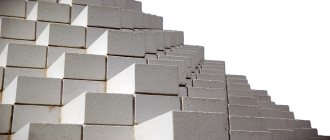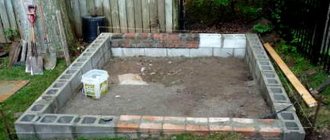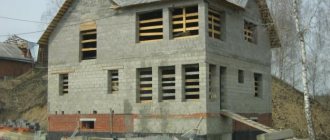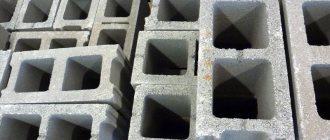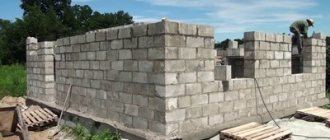The concept of cinder block weight is used in any construction project.
Building codes set the maximum weight of wall structures for the foundations of various types of buildings, from skyscrapers to small one-story residential buildings.
This characteristic is indicated by the manufacturer in quality certificates and the developer needs to know it in order to correctly calculate transportation costs, the type of transport and prepare the site for storage and storage of building materials.
What does the concept of mass mean?
This is an important indicator of wall material, which is determined by the formula:
Weight m = density p x volume V
The density of the material is determined by the manufacturer in the laboratory. To do this, the dried sample is carefully crushed to a powder state, after which the volume in a pycnometer is determined by the volume of liquid that was displaced by the solid powder.
For monolithic blocks, the volume will be equal to the product of all 3 of its dimensions . It is much more difficult to determine the characteristics of blocks that are not monolithic, but have internal empty cavities. In this case, their volume must be subtracted from the volume of the cinder block, determined by the external dimensions.
The standard or technological weight of cinder blocks, which is indicated in the quality certificate by the manufacturer, must be equal to the actual weight of the blocks, measured on weighing systems when loading the material into vehicles.
The discrepancy between this indicator and the technological weight indicates a discrepancy between the brand of blocks declared by the seller, which can lead to the fact that walls made of such material will quickly collapse, and the house will not acquire the necessary strength to be used for the prescribed period.
When determining this indicator, the developer needs to distinguish between its two varieties: volumetric and specific . The first - sets the volume occupied by solid particles and the voids between them, the second - only by solid particles, and therefore the first indicator is always less than the second. When designing, they use the volumetric weight indicator when calculating the strength of walls and the cost of commodity and transportation costs.
Why do you need to know?
This indicator of cinder blocks is taken into account when designing the facility. The developer of the design documentation determines not only the dimensions, modification of the wall material and its configuration, but also the manufacturer of the blocks with certain characteristics. The weight of even blocks of equal volume differs among manufacturers, which depends on the manufacturing technology and the percentage volume of the constituent ingredients.
The choice of block manufacturer is influenced by efficient cargo logistics and the cost of transportation costs. After selecting cinder blocks, the total mass is calculated for calculating the foundation, choosing the thickness of the walls and their reinforcement scheme .
How to calculate the required amount of material
Based on the size of the cinder block, you can accurately calculate the area of its side surface. And based on this indicator and the estimated total area of the wall, it is easy to calculate the number of products that will be needed for the job.
You can use 2 methods.
- We calculate the number of products based on the surface area of the wall being constructed. To do this, first determine the area of the wall (the product of length and width), then in the same way find the surface area that will make up the wall itself. Next, the first number is divided by the second.
- We calculate the number of blocks based on the volume of the finished structure: for this, the volume of the wall, the volume of the cinder block are determined, and the first number is also divided by the second.
EXAMPLE Let's assume that the wall area is 3*5 = 15 square meters. We take a standard size block, find the area of its lateral surface and convert it to m2: 0.188*0.390 = 0.07332 m2. We divide the area of the wall by the area of the block: 15/0.07332 = 204.58 and rounded up to as many as 205 blocks - this is exactly how many products we will need.
EXAMPLE. Let's assume that the volume of the wall is 3*5*2 = 30 m3. The volume of a block of standard sizes is determined by multiplying the length. width and height, and immediately convert it to cubic meters: 0.390*0.190*0.188 = 0.0140 m3. Divide the first number by the second: 30/0.0140 = 2142.857 and rounded to the nearest unit, i.e. 2143 cinder blocks will be needed to build such a wall (assuming, of course, that we will lay it only from this material).
Please note that if the wall is not rectangular, but has a complex shape (turns, bends), then its surface area can be calculated based on the sum of the rectangles that make up all the complex elements.
What does it depend on?
This indicator directly depends on the size and shape of the cinder block, as well as the density of the material making up the block. The greater the number of fillers that can be placed in a specific volume, the greater its mass will become.
It is logical that the type of filler becomes an essential condition for obtaining the mass of the block . Crushed stone and sand are used in the production of solid heavy cinder blocks, and all types of slag are used for light thermal insulation materials.
Additionally . The next indicator that affects the mass of blocks is the percentage of voids, which is set by the standard in the range from 28 to 40%. This indicator is also displayed by the plant in the cinder block quality certificate.
Conclusion
Low price and high performance indicators are what initially characterize our material. In construction, it is important to take into account all the parameters, because, for example, there is an option with a second floor, and there are partitions that put pressure not only on the base of the structure, but also on the ceiling, and all this must be taken into account.
Therefore, initially, at the design stage, we need to know all the parameters of the material, its dimensions and weight. In the video presented in this article you will find additional information on this topic.
What is the standard?
The mass of manufactured products is regulated by the standard , provided by production technology and indicated in the product passport. It also records the thermal conductivity, frost resistance and production method and the conditions for optimal use of the block for specific construction projects.
The weight of the blocks depends on the types of filler, their percentage composition , production methods, its strict adherence and must correspond to the indicator declared by the manufacturer. It is taken into account when developing a construction project for a facility and when calculating vehicles.
Prices for various brands
Product price. in addition to market factors, depends on:
- composition (that is, the filler included in the product);
- strength grade (the higher it is, the more expensive the block);
- sizes (the larger they are, the more expensive the block).
The comparison table allows you to analyze the relationship between these factors.
| Brand | Dimensions | Weight | Price | Filler |
| M-35 | 390*190*188 | 16 | 21 | Ash |
| M-50 | 390*190*188 | 18 | 22 | Ash |
| M-75 | 390*190*188 | 22 | 32 | Concrete |
| M-100 | 390*190*190 | 15 | 21 | Concrete |
| M-75 | 390*190*190 | 24 | 55 | Concrete |
| M-100 | 390*190*188 | 28 | 38 | Concrete |
| M-50 | 390*190*90 | 13 | 15 | Ash |
| M-75 | 390*190*188 | 11 | 23 | Crushed stone |
| M-75 | 390*190*90 | 13 | 28 | Concrete |
| M-100 | 390*190*188 | 28 | 47 | Concrete |
| M-100 | 390*95*188 | 18 | 70 | Sand cement |
| M-100 | 390*190*188 | 15 | 80 | Sand cement |
Requirements for different walls and foundations
For the construction of the foundation and plinth, as well as critical load-bearing wall structures, only a solid block with high strength indicators is used, which is provided by the ingredients: crushed stone, sand and concrete, pressed into one form on a vibrating machine.
Depending on the percentage composition of the ingredients, manufacturers produce foundation blocks with grades M100 and M125. With a typical size of 390x190x190, the weight of the block reaches 30 kg, and it can cope with enormous loads. Such blocks contain a larger amount of concrete, so they do not retain heat well, and therefore the walls will need additional thermal protection.
When installing internal walls and partitions, it is allowed to use M75 and M50 blocks with a hollowness of 28 to 40%. Cinder blocks with rectangular internal cavities are quite easy to cut and install.
A large number of sizes and technological methods for the production of cinder block wall material suggest the presence of a variety of weight standards in the distribution network.
Scope of application
Cinder block is famous for its multi-tasking properties. This material is used in different fields and has different purposes.
It is worth paying attention to the following examples:
- High-density products are used for the construction of residential buildings, while solid parts are used to make external walls in those buildings where there is more than 1 floor;
- This material is also used in the construction of baths; it is suitable for such buildings, as it is not afraid of fire and does not rot;
- You can build a garage from cinder blocks;
- these materials make reliable fences; for this purpose, it is recommended to use only frost-resistant, high-strength materials;
- cinder block foundation structures are easy to construct and also serve for many years; the strength of such a foundation will depend on the specific type of soil on the site and on the number of floors of future construction;
- Most often this material is used for laying walls; Thus, for external structures, solid parts or blocks with a voidness level of 30% are usually used;
- many owners build sheds from cinder blocks on their property; if the appearance of such a building does not play a special role, then absolutely any types of blocks (with any composition) are used for it;
- cinder blocks make good-quality gazebos, of course, people don’t turn to such structures so often, since a classic gazebo should be more elegant and attractive, but cinder block structures will be warmer and more stable; for such construction work, you can use materials in which the voidness level is 40%;
- Cinder blocks make excellent basements;
- it is permissible to use this material when constructing a rough plinth, and subsequently decorate it with decorative materials;
- if there is a noticeable difference between the threshold of the house and the plane of the yard, then it can be laid out with a cinder block porch, which can easily “smooth out” the difference; the rough structure can then be finished with tiles or porcelain stoneware - it all depends on the preferences of the owners;
- few people know, but it is quite possible to build an outdoor toilet from a cinder block; as a rule, such structures are additionally insulated, so it is permissible to use any type of block (even with a very low level of density);
- many consumers are wondering whether it is possible to build a swimming pool on the site from cinder blocks; in fact, experts still advise filling such structures with concrete, since the slag elements will absorb water and begin to collapse, it is better to make formwork from such blocks;
- some home craftsmen make barbecues from slag blocks; It is recommended to make the area where the fire will be lit from fire-resistant bricks, and lay out the lower part in blocks;
- a used cinder block is sometimes more expensive than a new one; as a rule, such materials were previously laid out using the correct technology and were manufactured at the factory; These types of slag blocks can be used for the construction of cesspools.
See the following video about the pros and cons of cinder blocks.
How much does 1 piece and cube weigh?
Based on the dimensions of the cinder block LxHxW mm, you can easily calculate the weight of 1m3. For this purpose, determine the number of blocks in 1 m3, and then multiply the resulting number by weight.
For example, for a solid block 400x200x200:
- find the volume: 0.4×0.2×0.2 = 0.016 m3;
- in one block there will be: 1 m3: 0.0161 m3 = 60.
The weight of 1 piece of block depends on the density and its percentage of hollowness; you can weigh it or take data from the passport.
Transportation of cinder blocks is carried out on special pallets, the characteristics of which are determined by the manufacturer of the product. Having information about the weight of the block, calculate the mass of the loaded pallet.
As usual, products are packaged in two standard pallet sizes:
- 1.2×0.8 m;
- 1.2×1.0 m.
They usually hold from 84 to 105 standard cinder blocks.
Calculation for size 400x200x200?
A block with such dimensions is used not only for the construction of walls, but also for design purposes , for example, for pavements and sidewalks. The design features of such blocks allow them to be used for the construction of buildings up to 3 floors.
Basically, for the production of standard wall materials, expanded clay with a void content of 28-40% is used. The structural characteristics of the block ensure the highest thermal conductivity, which guarantees the effectiveness of its use in residential construction. However, for the northern and eastern regions of the country, it will still be necessary to carry out additional insulation of the walls.
Calculation of the weight of a cinder block 40x20x20 cm, volume 0.016 m3, depending on the filler for solid 0% and hollow 28%:
- ash 1625 kg/m3 x 0.016 m3, 26/18 kg;
- brick and concrete 1875 kg/m3 x 0.016 m3, 30/21 kg;
- crushed stone and screenings 1750 kg/m3 x 0.016 m3, 38/20 kg;
- tripol and dolomite 1687 kg/m3 x 0.016 m3, 27/19 kg;
- gravel 1685 kg/m3 x 0.016 m3, 27/18 kg;
- expanded clay 1250 kg/m3 x 0.016 m3, 20/14 kg.
For 390x190x190
This modification of cinder block is used in practice in numerous areas of construction: residential, industrial and public. It is used for the construction of houses, shopping and entertainment centers, auxiliary buildings and fences .
Calculation of the weight of a cinder block 390x190x190 (mm), volume 0.014 m3, density 2200 kg/m3, depending on the percentage of voids:
- 0% - 0.014 m3x2200kg/m3x(1-0) = 30.8 kg;
- 20% - 0.014 m3x2200kg/m3x(1-0.2) = 24.64 kg;
- 30% - 0.014 m3x2200kg/m3x(1-0.3) = 21.56 kg;
- 35% - 0.014 m3x2200kg/m3x(1-0.35) = 20 kg;
- 40% - 0.014 m3x2200kg/m3x(1-0.4) = 18.48 kg.
Calculation of the mass of cinder block 390x190x190 (mm), volume 0.014 m3, density 1760 kg/m3, depending on the percentage of voids:
- 0% - 0.014 m3x1760kg/m3x(1-0) = 24.64 kg;
- 20% -0.014 m3x1760kg/m3x(1-0.2) = 19.71 kg;
- 30% - 0.014 m3x1760kg/m3x(1-0.3) = 17.25 kg;
- 35% - 0.014 m3x1760kg/m3x(1-0.35) = 16 kg;
- 40% - 0.014 m3x1760kg/m3x(1-0.4) = 14.78 kg.
Calculation of the weight of a cinder block 390x190x190 (mm), volume 0.014 m3, porosity 50%, density 1100 kg/m3, depending on the percentage of voids:
- 0% - 0.014 m3x1100 kg/m3 x (1-0) = 15.4 kg;
- 20% - 0.014 m3x1100 kg/m3 x (1-0.2) = 12.32 kg;
- 30% - 0.014 m3x1100 kg/m3 x (1-0.3) = 10.78 kg;
- 35% - 0.014 m3x1100 kg/m3 x (1-0.35) = 10 kg;
- 40% -0.014 m3 x 1100 kg/m3 x (1-0.4) = 9.24 kg.
Cinder block: making it yourself
Cinder block is a product that can be made at home. It is important to know the ratio of all components and take into account all the technology requirements at the mixing and molding stage.
Initial components and their correct ratio
The name itself suggests that the main filler of the raw material is slag, which is formed during production processes in a blast furnace. There is no single recipe for raw materials; it all depends on the quality of the starting components and mixing technology. One of the options for the ratios of the initial elements will be like this:
- Cement – 3 parts (it is better to take standard grades M400 or M500).
- Gravel - 4 parts (the sizes of the stones should be approximately the same and lie in the range of 5-20 mm).
- The main filler is slag – 14 parts.
- Water – approximately 5-6 parts.
The ratio of parts is everywhere implied by mass. If there is no slag, then you can use other materials in approximately the same quantities:
- sand
- crushed stone
- gypsum
- expanded clay
NOTE. If you work according to classical technology and use slag from a blast furnace, then no other additives listed above need to be added to the solution - this will spoil the strength properties of the finished products.
Mold making
You can prepare a mold for making cinder blocks of any size with your own hands from wooden boards. The shape parameters are directly related to the parameters of the finished product, and in this regard you have more freedom, since you can make blocks to your individual order (for example, for building a small extension to a house).
First, the appropriate measurements are taken, wooden boards are cut out, all parts are fixed only with the help of sliding grooves - this fastening is sufficient. Further, the product is reinforced from the outside with metal profiles. If you plan to make hollow cinder blocks, you need to make an additional device. You can learn more about this from this video.
IMPORTANT. Since wood quickly deteriorates from moisture, and work on the production of cinder blocks will constantly take place in conditions of high humidity, before starting work it is necessary to protect the mold parts by treating them with oil paint (preferably in 2 layers).
Cinder block manufacturing technology
Finally, when the mold is ready and all the initial components are measured in the required quantities, you should begin mixing the solution. To do this, all the constituent elements are poured together into a concrete mixer or into a regular container for manual work, water is added to them (first up to 3/4 of the original volume, and the whole mixture is thoroughly mixed until a mass is obtained, the consistency of which will be moderately viscous and also homogeneous by the look.
Finally, after obtaining the necessary raw materials, you can begin to mold them. The sequence of actions will be as follows:
- If you intend to make hollow blocks (in most cases this is exactly the case), then you need to prepare the required number of bottles made of durable glass (for champagne or other wines). PET containers will not work here, since they will not withstand the load of the solution.
- After this, the required amount of solution is poured into the mold, it is leveled, and the upper edge of the contents must completely coincide with the level of the mold (to obtain cinder blocks of the same size).
- The mold is left alone for 2-3 hours, after which the bottles that have formed voids can be carefully removed.
- Now you can remove the hardened solution from the mold. To do this, you first need to knock several times on the walls of the mold from all sides, and then, using shaking movements, carefully remove the raw product and place it on a previously prepared surface.
Usually 2 such bottles are fixed into each cell of the mold.
ADVICE. To do this procedure as carefully as possible and not damage the still fragile mixture, you need to carefully tap the bottles and remove them by rotating in one direction and the other. After this, immediately rinse them with water and set them aside - they will be useful for the next cycle.
Different technologies require different drying times. So, in the video example below, there is an option in which molding occurs immediately after putting the solution into the mold - it all depends on the composition of the raw materials and is often determined by eye.
Consequences of incorrect calculations
Developers who have dealt with the search and purchase of cinder block know that it, like any other wall material, can be of high quality or defective.
A high-quality block is one that is manufactured using standard technology, from high-quality raw materials and meets the conditions of GOST.
A defective stone can be easily determined by its weight; it does not meet the regulatory requirements for a given size and, as a rule, is always much lighter in weight than a quality product.
In the production of cinder blocks, defects occur for three reasons:
- violation of the composition of source materials;
- violation of vibration pressing technology;
- failure to maintain the drying regime.
Before purchasing, the developer should always check the actual and declared weight of the cinder blocks by the manufacturer. To do this, it is enough to measure the control batch on the scales and compare it with the passport data.
Main consequences of incorrect mass of cinder blocks:
- violation of the integrity of wall structures;
- purchasing an insufficient number of blocks for wall structures;
- incorrectly chosen type of house foundation;
- incorrect design of the vehicle for transporting the material.
Features of masonry
The main nuance and advantage when laying such stone is the significantly lower consumption of mortar compared to hollow blocks. There are no large holes in which you often have to put a large amount of solution.
A few nuances:
the solution must be plastic, so it is important to add plasticizers to its composition; the solution must be mixed in proportions 1:4 if cement grade M 400 is used; the mixture is applied with a trowel to the surface of the masonry and leveled with a spatula; the block is laid on masonry with cement applied and leveled; Be sure to tighten the lace before laying.
In addition to the surface of the masonry, the solution must be applied to the butt of the cinder block. It will hold well and will not spread, which will allow you to lay the stone correctly.
Briefly about the main thing
Cinder blocks have different shapes, materials and sizes. This building material has its own characteristics that must be used wisely in construction.
It is important to determine the type of blocks that are best suited for use on a particular construction site
You need to pay attention to the environmental characteristics of the material used. A cinder block house should not have more than three floors
Otherwise, excess pressure may act on the lower rows of blocks and the strength of the building is significantly reduced.
A cinder block house should not have more than three floors. Otherwise, excess pressure may act on the lower rows of blocks and the strength of the building is significantly reduced.
Knowing the size of cinder blocks will help determine the need for them and how much is already available on the construction site.
Construction of a foundation from blocks technology review
Typical construction of a prefabricated, strip foundation made of reinforced concrete or sand-cement blocks develops according to the following scheme:
First of all, a pit is dug at the construction site - a full-fledged rectangular excavation with beveled walls. As a result, the cross section of the excavation takes the shape of a trapezoid, and only the bottom of the pit corresponds to the dimensions of the foundation. Secondly, it is necessary to attend to the arrangement of a sand and gravel cushion, which improves the bearing capacity of the main soil and works as an element of the drainage system. In addition, at this stage, utility trenches are pulled to the foundation construction site. After arranging the bedding that levels the bottom of the pit, you can begin building the base of the foundation
And here you should be careful: after all, how much a concrete block for a foundation costs, so does the estimate for the construction of the foundation itself. Therefore, if a lightly loaded base is intended to be constructed, a BF type T-block can be used as a sole element, on top of which sand cement blocks are laid.
- The next step is the construction of the foundation strip. As mentioned above in the text, the technology for implementing this stage depends on the type of blocks used to construct the sole. Moreover, before laying the first layer of small-sized sand-cement blocks or large FBS elements, a layer of fastening mortar (one part cement and 3.5 parts sand) is applied to the upper edge of the base tape. Small blocks are laid manually, large concrete blocks are installed with a crane or winch. However, in both cases, the installation of the top layer is carried out according to the rules of classical dressing (the upper block is placed on the two lower ones, covering the vertical assembly seam with its body). The end seams of small blocks are filled with cement after laying, the vertical seam of large blocks is reinforced with steel studs (installed in advance at the ends of the reinforced concrete products) and filled with M250 or M300 concrete.
- After constructing the belt, a reinforcing belt is poured on top of the last layer of blocks, leveling the plane of the grillage.
Waterproofing and thermal insulation of the prefabricated strip base is carried out using standard methods. And after these procedures are completed, backfill soil is poured into the pit, filling the space between the slope and the base wall. Finally, a concrete blind area is built around the foundation and the base is finished.
About the site
zalman
Advantages of aerated block
Gas block has a number of advantages and is actively used in construction for the construction of walls.
- The material is lightweight, which makes it possible to install it yourself and simplify the construction of the foundation. Aerated blocks are easy to feed or transport to the installation site.
- The blocks are made under high pressure and temperature, which makes it especially durable.
- When constructing walls from aerated concrete, the thermal insulation properties are high. That is, in winter, the cold does not pass inside the room, and the heat does not go outside. A favorable microclimate is created in the room. Thus, additional insulation of the material is not required.
- Aerated blocks have a special structure that absorbs sounds, so this material has good soundproofing qualities.
- Aerated concrete products are easy to saw or drill, this does not create difficulties in work. There is no need for a special tool for this, just a file.
- Due to the large size and thin layer of adhesive composition, the installation speed increases. You can do the work yourself, which saves on costs.
- The material is universal; it is not only used to build walls, but also to construct other structures, partitions, various types of fencing, stairs, and others.
- Clear geometric dimensions ensure the evenness of the wall surface. The material does not shrink after the walls are erected.
- Mold or fungal elements do not appear on the surface of such a wall.
- Aerated concrete is fire resistant. An open fire does not support combustion; the material can withstand higher temperatures than during a fire. In case of fire, the structure retains its load-bearing capacity.
- The gas block has a high resistance to frost, this indicator is denoted by the letter “F”, followed by a number that shows the permissible amount of freezing. The material can last more than 35 years, thus, structures made from this material are durable.
- A building made of aerated concrete is considered “breathable”, since the material has a porous structure. Therefore, air can circulate freely, while the humidity level is regulated. Thanks to this, a favorable microclimate for living and comfort is created in the room.
- The material is highly environmentally friendly. Aerated blocks are environmentally friendly and do not emit harmful substances that have a negative effect on the environment and human health.
- Insects and other pests do not grow in such structures.
The material is of high quality, thanks to production technology. Gas blocks are popular due to their ease of installation. Due to its low weight, the material is easy to transport, transfer to the installation site, and rise to the required height when constructing the wall surface in the upper part. This building material allows you to complete construction work several times faster. At the same time, you can save on costs, that is, installation is carried out independently, there is no need for special experience or knowledge. The material has high sound-proofing and heat-insulating properties, this makes it possible not to use additional insulation, such a surface is simply plastered, thus saving costs on finishing materials.
Before starting construction work, it is necessary to calculate the amount of material purchased; for this it is important to know its dimensions in order to calculate the volume. And then they begin to calculate the number of pieces in one pallet, so they determine how many pallets need to be purchased to build the entire structure
With the correct calculation, you can purchase all the material at once to avoid additional delivery in the future.
Briefly
The amount of material for laying walls can be calculated in various ways. If you know the size of a standard cinder block, the calculator on any major online construction resource will do this in a matter of minutes.
It is not much more difficult to calculate this yourself using the volume formula and taking into account the thickness of the solution.
However, since such products are not ordered individually, but in batches that fit on a construction pallet, it is important to know the batch size.
Let's say you need one pallet of breeze blocks, the price of each 20x20x40 block in the country is about 25-40 rubles. For example, let’s calculate the cost of a pallet of blocks (40 rubles per block): we get 84 × 40 = 3360 rubles.


